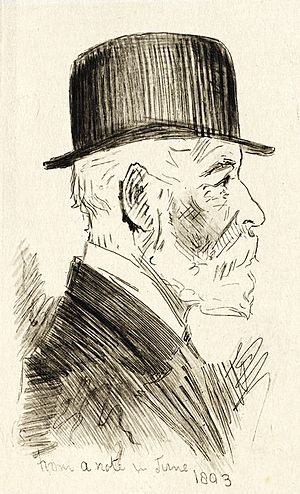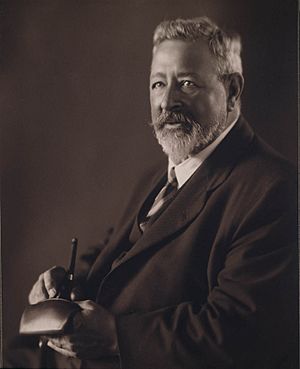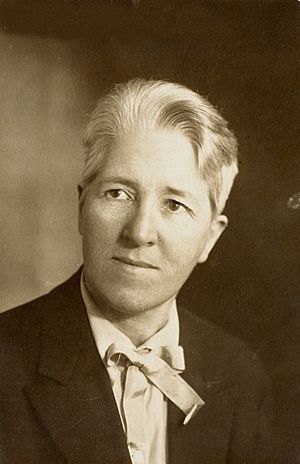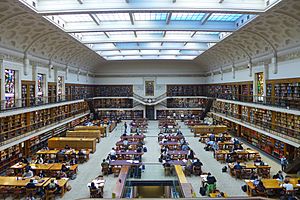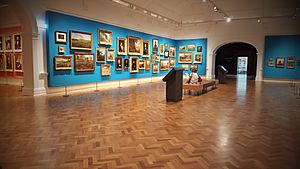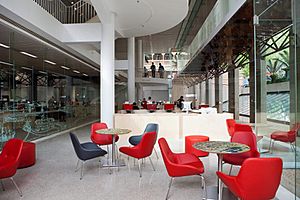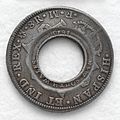State Library of New South Wales facts for kids
Quick facts for kids State Library of New South Wales |
|
|---|---|
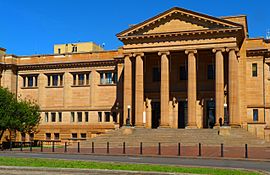 |
|
| State Library of New South Wales, Mitchell Building, exterior | |
| Country | Australia |
| Type | State Library |
| Established | 1826 |
| Reference to legal mandate | Library Act 1939 |
| Location | Macquarie Street and 1 Shakespeare Place, Sydney central business district, City of Sydney, New South Wales |
| Coordinates | 33°51′58″S 151°12′48″E / 33.86611°S 151.21333°E |
| Collection | |
| Size | 5 million items (5,000,000) |
| Legal deposit | Since 1879 |
| Other information | |
| Budget | A$91.7 million |
| Director | Dr John Vallance (State Librarian) |
The State Library of New South Wales is a very old and important library in Sydney, Australia. It's like a giant treasure chest of books, maps, photos, and old papers for everyone to use. It's the oldest library in Australia, first opening its doors in 1826. You can find it in the heart of Sydney, near the beautiful Royal Botanic Gardens.
The library building was designed by Walter Liberty Vernon and built between 1905 and 1910. Over the years, more parts were added. This special building was officially added to the New South Wales State Heritage Register in 1999 because of its history and beauty.
Contents
History of the State Library
The first collection of books for this library was part of the Australian Subscription Library, which started in 1826. Back then, you had to pay a fee to be a member. In 1869, the government bought it for £5,100 and made it the Sydney Free Public Library. This meant everyone could use it for free! In 1895, it was renamed the Public Library of New South Wales, and then in 1975, it became the State Library of New South Wales.
How the Library Started (1826–1900)
The Australian Subscription Library began in 1826. It moved around a few times in Sydney before a new building was started in 1843. This new building opened in 1845.
By 1869, the subscription library was in financial trouble. The government stepped in and bought it, turning it into the Sydney Free Public Library. It opened with 20,000 books, and over 60,000 people visited in its first year! Robert Cooper Walker became the main librarian. He worked hard to make the library even better by adding more books and creating lists of what the library had.
The library also started a lending branch in 1877, so people could borrow books. It even began sending books to other towns in New South Wales from 1883. The library's collection grew, adding important items like a First Folio (an old collection of Shakespeare's plays) in 1885 and the papers of William Bligh (from the famous mutiny) in 1902.
Special Gifts: Mitchell and Dixson Collections (1900–1929)
The library really wanted to collect items about Australia. A man named David Scott Mitchell was also collecting many books and papers about Australia and the Pacific. He had so many that the library couldn't compete with him!
In 1898, Mitchell decided to give his amazing collection to the people of New South Wales. He had one main condition: the collection had to be called the "Mitchell Library". His offer was accepted quickly, but it took a few years to build a new part of the library to hold his collection.
Construction started in 1906, a year before Mitchell passed away. In 1909, a new job was created called the Mitchell Librarian, just for looking after Mitchell's collection. The Mitchell Library officially opened on 8 March 1910.
Mitchell hadn't made a list of all his books, so the librarians had to work hard to catalogue everything. The library also focused on getting more Australian and Pacific items. They acquired important papers from people like Lachlan Macquarie (an early governor) in 1914 and Matthew Flinders (an explorer) in 1922.
Another important person, Sir William Dixson, offered his collection of Australian and Pacific pictures and manuscripts to the library in 1919. His collection was also very special. A new part of the building, called the Dixson Wing, was built to house his collection and opened in 1929. Dixson even paid for the beautiful bronze doors added to the Mitchell building in 1942. His entire collection came to the library after he died in 1952.
Growing and Changing (1930–1980)
In 1932, Ida Leeson became the Mitchell Librarian. This was a big deal because it was a very senior role, and at that time, it was unusual for a woman to hold such a high position.
In 1934, a report suggested that Australia needed more free public libraries. This led to the Library Act 1939, which helped set up free public libraries in every local area. This was a huge step for making books available to everyone.
The library continued to grow its collection, adding important items like the Macarthur family papers in 1940 and the papers of famous Australian writer Miles Franklin in 1954. They also started collecting stories from soldiers after World War I.
In 1970, the papers of poet Dorothea Mackellar were acquired, and in 1972, the designs for the Sydney Opera House by Jørn Utzon came to the library. The library even started an oral history project in 1976, recording interviews with past staff members.
Gallery
The Library Today
In the 1980s, the library started using computers to list its collections. This made it much easier to find books! The library also began to focus more on collecting stories and items from Indigenous Australians and different cultural groups. They even created special jobs for Indigenous Services Librarians in 1991.
In 1998, the library bought two very large collections. One was the papers of George Bass, an early explorer. The other was the collection of author and dancer Jean Garling. The library continues to add new and important items to its collections all the time.
In 2014, there was a discussion about proposed changes to the Mitchell Library. Many writers and historians spoke up, and the library listened. They decided to restore the library to its original plans.
In March 2020, the library buildings had to close to the public because of COVID-19. But they still offered many services online. They reopened in July 2020, following health guidelines.
The Library Building
The Mitchell Building
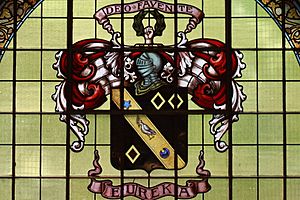

By the 1890s, the library needed more space. David Scott Mitchell's generous gift of his huge collection was the perfect reason to build a new "national" library.
Work on the Mitchell Wing began in 1906 and finished in 1910. It was designed by Walter Liberty Vernon, the main architect for the government. This part of the building used to have the Mitchell Library reading rooms and galleries.
In 1939, work started on the central part of the building. This included the grand entrance, the beautiful foyer with a marble mosaic map of Tasman's voyages, and the main reading room. The whole library was finally under one roof by June 1942. The bronze doors, paid for by William Dixson, show images of Indigenous Australians and early European explorers. The Mitchell Wing celebrated its 100th birthday in 2010.
The Dixson Wing
Twenty years after the Mitchell Wing was finished, another part was added: the Dixson Wing. It was completed in 1929 and was built to store and display Sir William Dixson's large collection of historical paintings.
The Macquarie Street Building
The library needed even more space for its growing collection and for people to use. Work on the Macquarie Street Wing began in 1983 and it opened in 1988. Queen Elizabeth II herself opened the new building! This new part faces Macquarie Street and connects to the Mitchell Wing. In 2011, this building was updated with a new reading room and learning spaces.
What's in the Collection?
The State Library has over 5 million items! This includes more than 2 million books, 1.1 million photographs, newspapers, maps, and old letters. It also collects digital items and is part of a project to save websites for the future.
Besides being a general library, it has many very old and important collections from when Europeans first came to Australia. These include nine of the eleven surviving journals from the First Fleet, stories from Australian explorers, and many historical records. These special items are kept in two main collections: the Mitchell Library (named after David Scott Mitchell) and the Dixson Library (named after Sir William Dixson). The library keeps adding to the Mitchell Library, but the Dixson Library is Dixson's original collection and doesn't get new items added.
Cool Collection Highlights
Here are some amazing items you can find in the library:
- All six issues of the Australian Abo Call newspaper.
- Journals from famous explorers like Joseph Banks (who sailed with James Cook), Harold Lasseter (who searched for gold), and William Bligh (from the Bounty mutiny).
- Huge photo collections, including the UNESCO-listed Holtermann Collection of old goldfield photos, and pictures by famous photographers like Frank Hurley and Max Dupain.
- Original handwritten copies of famous Australian poems and books, like The Man from Snowy River by Banjo Paterson and Seven Little Australians by Ethel Turner.
- A holey dollar and dump from 1813 – these were some of the first coins made in New South Wales!
- One of the very first books published in Australia, the New South Wales General Standing Orders.
-
Holey dollar and dump first distinct NSW coinage
(1813) -
Dr William Bland – the oldest-surviving Australian photograph
(c. 1845) -
Photos of Shackleton's expedition to Antarctica by Frank Hurley
(1915)
Digital Resources and Online Access
The library started putting its collection information on computers in the 1980s. This made it much easier to find things! They also have many online databases that you can access with a library card from home.
The library has been working hard to digitise (make digital copies of) its old manuscripts and pictures. This includes the papers of Joseph Banks and Matthew Flinders, and the famous Holtermann Collection of goldfield images. You can see many of these digitised items online through the library's website. In 2012, the government gave the library money to digitise 12 million pages from its collection!
Legal Deposit: Saving Every Book
In Australia, there are special laws called "legal deposit" laws. These laws mean that a copy of every book, newspaper, map, and other published item in New South Wales must be given to the State Library. This helps make sure that all of Australia's history and culture is saved and available for everyone to see and use. The library also works with other libraries across Australia to collect electronic publications online.
Library Services
It's free to visit the library's reading rooms and galleries! If you have a library card, you can also access electronic resources from home, get books from storage, and book study rooms. The library often has free exhibitions, showing off its own collections or special displays from other places.
Helping Other Libraries in NSW
The State Library also helps all the other public libraries in New South Wales. It gives them information, training, advice, and even money to help them run their services. They also do research to help public libraries improve their buildings and services.
Who Runs the Library?
The State Library of New South Wales is part of the New South Wales State Government. It's looked after by the Ministry of Arts.
State Librarian
The State Librarian is the main person in charge of the library. This role is very important and has been around since 1827. Here are some of the people who have been State Librarian:
| Number | Name | Started | Finished | Time in Office |
|---|---|---|---|---|
| 1 | Peter Cooke | 1827 | 1829 | 2 years |
| 7 | Robert Cooper Walker | 1869 | 1893 | 24 years |
| 8 | Henry Charles Lennox Anderson | 1893 | 1906 | 13 years |
| 10 | William Herbert Ifould | 1912 | 1942 | 30 years |
| 11 | John Wallace Metcalfe | 1942 | 1959 | 17 years |
| 13 | Russell Fletcher Doust | 1973 | 1987 | 14 years |
| 14 | Alison Laura Crook | 1987 | 1995 | 8 years |
| 19 | Hon. Professor John Vallance | 2017 | Current | 8 years, 113 days |
Mitchell Librarian
Because of David Scott Mitchell's special gift, there is also a specific job called the Mitchell Librarian. This person is in charge of the Mitchell Collection. Here are some of the people who have held this role:
| Number | Name | Started | Finished | Time in Office |
|---|---|---|---|---|
| 1 | Hugh Wright | 1909 | 1932 | 23 years |
| 2 | Ida Leeson | 1932 | 1946 | 14 years |
| 3 | Phyllis Mander-Jones | 1947 | 1957 | 10 years |
| 5 | Suzanne Mourot | 1973 | 1979 | 6 years |
| 10 | Richard Neville | 2008 | Current | 16–17 |
Getting There: Transport Connections
You can get to the State Library of New South Wales by:
| How to get there | Station/Stop | Lines/Routes |
|---|---|---|
Trains |
Martin Place | |
| St James | *
|
|
| Circular Quay | ||
Buses |
Macquarie Street | 200, Sydney Explorer |
Ferries |
Circular Quay | Check timetable |
Why the Library is Special (Heritage Listing)
The State Library of New South Wales is a very important building in Australia. It's one of the oldest public libraries in Sydney and has been used continuously since it was built. It's also famous for its beautiful design and its important location on Macquarie Street.
The building was added to the New South Wales State Heritage Register in 1999 because:
- It shows how history has unfolded in NSW: The Mitchell Wing has been a public library since 1907 and is the oldest remaining purpose-built library in Sydney. Many important people, like Walter Liberty Vernon (the architect), have been involved with the building. It holds unique collections about Australia that are kept for everyone.
- It's important to the community: The library holds special collections about Australia, which helps people understand their history and where they come from. It was even finished during World War II, showing how important it was to the community.
- It can teach us about history: The original Mitchell Stack (a part of the building for storing books) was very new and clever for its time. It was also one of the first public buildings in NSW to have air conditioning!
- It's rare and unique: The building's style is uncommon for public buildings in Sydney, making it a rare and special example of its kind.
Images for kids
See also
 In Spanish: Biblioteca Estatal de Nueva Gales del Sur para niños
In Spanish: Biblioteca Estatal de Nueva Gales del Sur para niños


